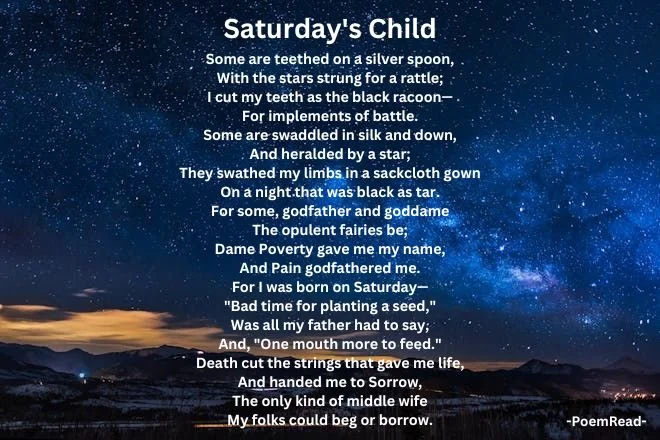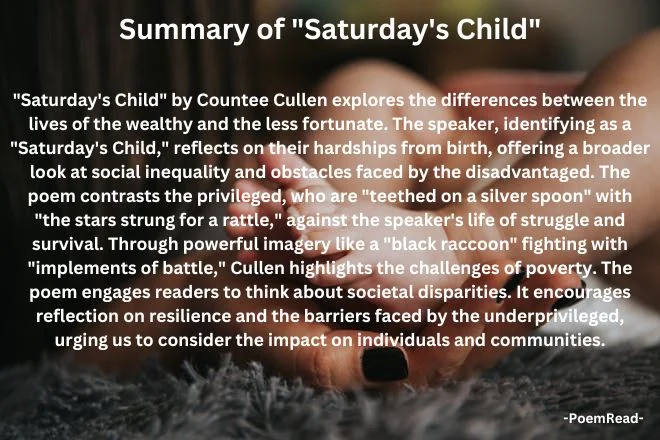“Saturday’s Child” by Countee Cullen: An Analysis
June 24, 2024 | by poemread.com

“Saturday’s Child” by Countee Cullen is more than just a poem—it’s a deep reflection on social inequality and the resilience of the human spirit. Written during the Harlem Renaissance, a time of immense cultural and artistic growth for African Americans, Cullen’s work captures the contrasts between lives of privilege and those marked by poverty.
With striking imagery and powerful symbolism, the poem invites readers to explore the systemic barriers that shape our world and to empathize with those who navigate these harsh realities. Join us as we explore the meaning within “Saturday’s Child,” uncovering the messages that continue to resonate today.
Saturday's Child
Some are teethed on a silver spoon,
With the stars strung for a rattle;
I cut my teeth as the black racoon—
For implements of battle.
Some are swaddled in silk and down,
And heralded by a star;
They swathed my limbs in a sackcloth gown
On a night that was black as tar.
For some, godfather and goddame
The opulent fairies be;
Dame Poverty gave me my name,
And Pain godfathered me.
For I was born on Saturday—
"Bad time for planting a seed,"
Was all my father had to say,
And, "One mouth more to feed."
Death cut the strings that gave me life,
And handed me to Sorrow,
The only kind of middle wife
My folks could beg or borrow.
Content
- About the Author: Countee Cullen
- Subject of “Saturday’s Child”
- Context of “Saturday’s Child”
- Theme and Tone of “Saturday’s Child”
- Persona, setting, and narrative in "Saturday's Child"
- Form and Structure of “Saturday’s Child”
- Line-by-Line Analysis of “Saturday’s Child”
- Poetic and Literary Devices Used in “Saturday’s Child”
- FAQ: “Saturday’s Child” by Countee Cullen
- Implications and Meanings of "Saturday's Child"
- Interactive Summary
About the Author: Countee Cullen
Countee Cullen, born in 1903, was a prominent figure in the Harlem Renaissance, a cultural movement that celebrated African American artistic expression in the 1920s and 1930s. Cullen’s upbringing and education laid the foundation for his literary career. His grandmother raised him in a nurturing environment in New York City. He later attended New York University and subsequently earned a master’s degree from Harvard University. His academic achievements and intellectual rigor would deeply influence his poetic voice.
Cullen’s poetry often addressed themes of racial identity and social injustice, reflecting the complex societal challenges faced by African Americans during his era. His works stand out for their lyrical quality and use of classical forms, which are juxtaposed with explorations of race and identity. Notable collections such as “Color” (1925) and “Copper Sun” (1927) showcase his talent for melding traditional poetic forms with contemporary themes, making his work both accessible and profoundly moving.
In “Saturday’s Child,” Cullen’s exploration of racial and economic disparities is evident. The poem delves into the lived experiences of African Americans in a society rife with inequality. It is through Cullen’s unique perspective and life experiences that he is able to convey the emotional depth and societal critique found within this work. His experience navigating racial identity and positioning within both black and white literary circles gave him an extensive understanding of how race, class, and art intersect.
Throughout his career, Cullen’s contributions to American poetry have been widely recognized for their emotional intensity and intellectual depth. Cullen’s skill in expressing the African American experience through classical forms ensures that his work remains relevant and impactful across generations. His legacy as a poet and advocate for social awareness has left a lasting mark on American literature.
Subject of “Saturday’s Child”
“Saturday’s Child” by Countee Cullen explores the contrasts between children born into privilege and those born into poverty. The speaker, identifying as a “Saturday’s Child,” reflects on their own experiences of hardship from birth. This reflection offers a broader commentary on social inequality and systemic barriers.
The poem begins by contrasting the lives of the privileged, who are “teethed on a silver spoon” with “the stars strung for a rattle,” against the speaker’s life of struggle and survival. The imagery of a “black raccoon” cutting its teeth “for implements of battle” highlights the harsh realities faced by the impoverished. This contrast sets the stage for exploring social disparity.
Cullen continues to highlight these differences. Some children are “swaddled in silk and down” and “heralded by a star,” while the speaker is wrapped in a “sackcloth gown” on a night “black as tar.” This imagery emphasizes the humble and challenging beginnings of the speaker’s life.
The poem also addresses the role of godparents. The privileged have “opulent fairies” as godfathers and goddames, while “Dame Poverty” names the speaker and “Pain” acts as their godfather. This personification of poverty and pain highlights the systemic nature of the speaker’s struggles.
Being a “Saturday’s Child” traditionally symbolizes a life of hard work and struggle. The father’s pessimistic view of the speaker’s birth, labeling it a “bad time for planting a seed” and “one mouth more to feed,” emphasizes the economic strain often felt by poor families at the birth of a child.
The poem concludes with reflections on death and sorrow. The speaker suggests that “death cut the strings that gave me life” and handed them to “sorrow,” reinforcing the theme of hardship and inevitable suffering.
Context of “Saturday’s Child”
Countee Cullen wrote “Saturday’s Child” during the Harlem Renaissance, a cultural movement in the 1920s and 1930s celebrating African American art, literature, and music. This era highlighted vibrant black cultural expression and renewed racial pride. However, it was also a time of significant racial and economic inequality in the United States.
The Harlem Renaissance followed the Great Migration, when millions of African Americans moved from the rural South to urban centers in the North. They sought better economic opportunities and an escape from Jim Crow laws. Despite their hopes, many faced continued discrimination, segregation, and economic hardship.
Countee Cullen, a leading figure in this movement, used his poetry to address these issues. “Saturday’s Child” reflects the broader social context of early 20th-century America. At that time, systemic barriers and racial discrimination created significant disparities in opportunities and life circumstances.
Through contrasts between the lives of the privileged and the underprivileged, Cullen critiques these social and economic structures. Drawing from his own experiences and observations, Cullen combines personal insight with broader social commentary.
“Saturday’s Child” portrays the speaker’s life of hardship and resilience. It highlights the disparities in wealth and opportunity while emphasizing the strength required to overcome these challenges. The poem serves as a reminder of the systemic barriers faced by the underprivileged and the resilient spirit of those striving to overcome them.
Theme and Tone of “Saturday’s Child”

Theme
The central theme of “Saturday’s Child” by Countee Cullen is social inequality. The poem contrasts the lives of the privileged and the underprivileged, highlighting the disparities in opportunities and life circumstances. Through the speaker’s reflections, Cullen explores how systemic barriers and economic hardship shape the experiences of those born into poverty.
Another significant theme is resilience. Despite the harsh realities depicted in the poem, the speaker’s narrative conveys a sense of determination and strength. The metaphors of struggle and survival emphasize the fortitude necessary to deal with adversity in life. This theme resonates with the broader experiences of African Americans during the Harlem Renaissance, who faced significant challenges yet continued to strive for a better future.
Tone
The tone of “Saturday’s Child” is somber and reflective. Cullen uses evocative language and imagery to convey the speaker’s experiences of hardship and struggle. As the speaker acknowledges the systemic obstacles and financial difficulties they face, the poem has a realistic tone.
However, there is also an undercurrent of resilience and hope. Despite the somber tone, the speaker’s reflections on their life are imbued with a sense of determination. The mixture of somber realism and resilient hope in the poem’s tone adds depth and emphasizes the complexity of the speaker’s experiences.
The use of personification, such as “Dame Poverty” and “Pain godfathered me,” adds a layer of emotional depth to the poem. These personifications highlight the pervasive nature of poverty and suffering in the speaker’s life while also emphasizing their ability to endure and persevere.
Persona, setting, and narrative in “Saturday’s Child”
Persona
The persona in “Saturday’s Child” is the speaker who identifies as a “Saturday’s Child.” This persona represents individuals born into poverty and facing the harsh realities of economic disadvantage from birth. Through the persona of the speaker, the poem provides a personal and intimate perspective on the challenges, struggles, and resilience of those marginalized by society. The persona allows readers to empathize with the speaker’s experiences and gain insight into the systemic barriers faced by the underprivileged.
Setting
The setting of “Saturday’s Child” isn’t explicitly specified in terms of location or time. However, the setting can be inferred from the socio-economic context of the Harlem Renaissance, during which the poem was written. This era saw a cultural and artistic boom among African Americans, but it also grappled with widespread racial and economic inequality. This historical setting provides a background for understanding the social conditions that influenced the speaker’s experiences and the themes of social injustice and resilience explored in the poem.
Narrative
The narrative in “Saturday’s Child” unfolds through imagery, symbolism, and personal reflection. The speaker narrates their own experiences of hardship and survival, contrasting their life with that of the privileged. The narrative is characterized by a tone of somber realism, depicting the harshness of poverty and the challenges faced by the underprivileged. However, the narrative also contains elements of resilient hope, indicating the speaker’s determination to persevere despite adversity.
Form and Structure of “Saturday’s Child”
“Saturday’s Child” by Countee Cullen is a well-crafted poem that follows a structured form, enhancing its thematic impact and readability. Let’s break down its form and structure in detail:
Stanzas and Line Length
The poem consists of five quatrains, meaning it has five stanzas, each containing four lines. This consistent structure helps to create a rhythmic flow, making the poem engaging and easier to follow.
Rhyme Scheme
The poem follows an ABAB rhyme scheme throughout. This means that the first and third lines of each stanza rhyme with each other, as do the second and fourth lines. For example, in the first stanza:
- Some are teethed on a silver spoon, (A)
- With the stars strung for a rattle; (B)
- I cut my teeth as the black racoon— (A)
- For implements of battle. (B)
This rhyme scheme adds a musical quality to the poem, making it more memorable and emphasizing the contrasts Cullen draws between the lives of the privileged and the underprivileged.
Meter
The poem employs iambic tetrameter, where each line typically contains four metrical feet, each consisting of an unstressed syllable followed by a stressed syllable. This metrical pattern contributes to the poem’s steady rhythm and highlights the lyrical nature of Cullen’s writing.
Pauses and Line Breaks
Cullen uses line breaks and punctuation effectively to create pauses and emphasize certain ideas. For instance, the use of commas and periods helps to break the flow, allowing readers to pause and reflect on the imagery and meaning of each line. This technique also adds to the poem’s rhythmic quality.
Punctuation
The poem contains a moderate amount of punctuation, including commas, periods, and dashes. This punctuation helps to control the pace of the poem, guiding the reader through the narrative and emphasizing key points. For example, the dash in “For I was born on Saturday” creates a pause that highlights the significance of the speaker’s birthday.
Consistency and Variation
While the poem maintains a consistent structure with its quatrains and rhyme scheme, Cullen also introduces variation through his use of imagery and language. This balance between consistency and variation keeps the poem engaging and dynamic, allowing readers to appreciate both its form and its content.
Significance of the Form
The structured form of “Saturday’s Child” serves several purposes. Firstly, it creates a sense of order and rhythm, which contrasts with the chaotic and challenging life described by the speaker. This contrast underscores the poem’s themes of inequality and resilience. Secondly, the rhyme scheme and rhythmic flow make the poem more accessible and memorable, helping to convey its powerful message effectively.
Line-by-Line Analysis of “Saturday’s Child”

First Stanza
Some are teethed on a silver spoon,
With the stars strung for a rattle;
I cut my teeth as the black raccoon—
For implements of battle.
The first stanza of “Saturday’s Child” sets up a vivid contrast between privilege and poverty. Cullen uses rich, evocative imagery to describe the lives of the privileged, juxtaposed with the speaker’s own life of struggle. This stark contrast emphasizes the poem’s central theme of social inequality and the systemic barriers faced by those born into poverty. Through this juxtaposition, Cullen effectively engages the reader and sets the tone for the rest of the poem.
“Some are teethed on a silver spoon,”
This line immediately introduces the theme of privilege. The phrase “teethed on a silver spoon” is a metaphor for being born into wealth and ease. It suggests that some children start life with every advantage, with the silver spoon symbolizing luxury and comfort.
“With the stars strung for a rattle;”
This line continues to highlight the privileged upbringing of some children. The imagery of “stars strung for a rattle” conveys a sense of enchantment and luxury. It suggests that even the simplest toys for these children are extraordinary, emphasizing their fortunate beginnings. Additionally, the stars symbolize high status and the best of everything. It suggests that these kids are not only born into wealth but also grow up in a world of beauty and excellence.
“I cut my teeth as the black raccoon—”
Here, speaker contrasts their own experience with that of privileged children. The phrase “cut my teeth” signifies growing up or learning through experience. Comparing themselves to a “black raccoon” introduces a stark, harsh image. Raccoons are often associated with scavenging and survival, indicating a tough, struggle-filled childhood.
“For implements of battle.”
This line deepens the sense of struggle introduced in the previous line. The “implements of battle” metaphorically represent the tools needed for survival. It suggests that the speaker’s upbringing involved constant fighting and hardship, contrasting sharply with the luxury described in the first two lines.
This line reinforces the theme of social inequality. It suggests that, from a very young age, the speaker has had to be ready to fight and defend themselves. Therefore, it highlights the differences in the upbringing and life experiences of the privileged versus the underprivileged.
Second Stanza
Some are swaddled in silk and down,
And heralded by a star;
They swathed my limbs in a sackcloth gown
On a night that was black as tar.
The second stanza of “Saturday’s Child” reinforces the poem’s theme of social inequality. By contrasting the luxurious beginnings of some children with the speaker’s own challenging start, Cullen highlights the differences in life circumstances. The imagery of silk and down versus sackcloth and a star versus a night black as tar, powerfully illustrates the systemic barriers and hardships faced by those born into poverty. This juxtaposition continues to build the poem’s emotional impact and deepens the reader’s understanding of the pervasive nature of social inequality.
“Some are swaddled in silk and down,”
This line continues to emphasize the disparity between the privileged and the underprivileged. “Swaddled in silk and down” suggests that some children are wrapped in luxurious, soft, and expensive materials from birth. Silk and down symbolize wealth, comfort, and care, highlighting the pampered lives of the privileged. The word “swaddled” implies care and protection, further emphasizing the nurturing environment provided to these children.
“And heralded by a star;”
This line adds to the sense of grandeur and specialness surrounding the birth of privileged children. The imagery of being “heralded by a star” suggests that the birth of these privileged children is celebrated and marked by lucky omens. Stars are often associated with guidance, hope, and destiny, implying that these children are seen as special and destined for greatness. It suggests that their arrival is celebrated and marked by an extraordinary sign.
“They swathed my limbs in a sackcloth gown”
In stark contrast, the speaker describes their own birth. “Swathed my limbs in a sackcloth gown” presents a harsh, rough, and uncomfortable image. Sackcloth is a coarse material typically associated with mourning or poverty. This line shows the humble and difficult beginnings of the speaker’s life, compared to the luxurious start of the privileged. Additionally, it suggests a life of hardship and deprivation from the very start.
“On a night that was black as tar.”
This final line of the stanza intensifies the sense of bleakness surrounding the speaker’s birth. “A night that was black as tar” creates a deep, impenetrable darkness, suggesting a lack of hope or joy. The comparison to tar, a sticky and oppressive substance, adds to the imagery of hardship and struggle. It implies that the speaker’s life began in an environment devoid of light or prospects.
Third Stanza
For some, godfather and goddame
The opulent fairies be;
Dame Poverty gave me my name,
And Pain godfathered me.
The third stanza of “Saturday’s Child” deepens the poem’s exploration of social inequality through the metaphor of godparents. By contrasting the “opulent fairies” who guide the privileged with the speaker’s own godparents, “Dame Poverty” and “Pain,” Cullen showcases the systemic nature of social and economic disparities.
The use of personification to describe these guiding forces adds emotional weight and illustrates how deeply entrenched these struggles are in the speaker’s life. This stanza reinforces the poem’s central theme of the differences between the lives of the privileged and the underprivileged, emphasizing the impact of these disparities on one’s identity and destiny.
“For some, godfather and goddame”
This line begins with the idea of godparents, which traditionally are individuals who provide guidance and support in a child’s life. The use of “godfather and goddame” here refers to the spiritual and social guardianship that privileged children receive.
“The opulent fairies be;”
The imagery of “opulent fairies” suggests that the godparents of privileged children are not just ordinary people but are almost magical in their ability to provide wealth and opportunities. The word “opulent” conveys a sense of great wealth and luxury, highlighting how affluent their surroundings are for these kids.
Fairies are often associated with granting wishes and bestowing gifts, symbolizing the fortunate circumstances and additional support that privileged children receive. Together, these words indicate that the privileged have guardians who are both wealthy and generous, ensuring a life of ease and protection.
“Dame Poverty gave me my name,”
In contrast, the speaker’s godmother is “Dame Poverty.” This personification of poverty as a noble title, “Dame,” adds a layer of irony. The speaker’s life is characterized from the start by poverty rather than wealth and comfort. Naming is a powerful act, and by stating that poverty gave them their name, the speaker highlights how deeply poverty is ingrained in their identity and life circumstances.
“And Pain godfathered me.”
Continuing the contrast, the speaker’s godfather is “Pain.” This personification emphasizes that suffering and hardship are constant companions in the speaker’s life. Unlike the privileged children with their “opulent fairies,” the speaker is guided and shaped by the harsh realities of poverty and pain.
Fourth Stanza
For I was born on Saturday—
“Bad time for planting a seed,”
Was all my father had to say,
And, “One mouth more to feed.”
The fourth stanza of “Saturday’s Child” focuses on the immediate reactions and practical concerns surrounding the speaker’s birth. Cullen uses vivid imagery and metaphor to highlight both the economic strain and emotional burden experienced by the family. The designation as a “Saturday’s Child” sets the stage for a life filled with struggle and hard work. Meanwhile, the father’s resigned and pragmatic response underscores the harsh realities faced by the family.
In this stanza, Cullen continues to explore the theme of social inequality by emphasizing the economic pressures and lack of resources available to the underprivileged. The father’s words reflect a sense of inevitability and resignation, highlighting the systemic barriers that sustain poverty and hardship. Through these lines, Cullen effectively conveys the emotional and practical challenges faced by the speaker from birth. This adds depth to the poem’s exploration of social inequality and resilience, allowing readers to empathize with the speaker’s experiences.
“For I was born on Saturday—”
This line introduces the idea of being a “Saturday’s Child,” which traditionally symbolizes a life of hard work and struggle. The speaker’s birth on Saturday sets the tone for the challenges they will face throughout their life. Furthermore, the line alludes to the traditional nursery rhyme “Monday’s Child,” where a child born on Saturday is said to “work hard for a living.”
“Bad time for planting a seed,”
The speaker’s father’s words, “Bad time for planting a seed,” are a metaphor suggesting that the speaker’s birth came at an inopportune moment. This agricultural metaphor implies that the environment or circumstances were not conducive to nurturing new life, highlighting the family’s difficult situation.
This line also reflects a sense of pessimism and resignation. The father’s words convey a lack of hope and a sense of inevitability about the struggles that lie ahead.
“Was all my father had to say,”
This line characterizes the father as a pragmatic and perhaps emotionally detached figure. His brief and resigned response to the speaker’s birth highlights the family’s difficult circumstances and the father’s awareness of the additional burden a new child represents. The tone here is one of resignation and practicality. The father’s lack of enthusiasm shows the harsh realities faced by the family.
“And, ‘One mouth more to feed.'”
The father’s additional remark, “One mouth more to feed,” underscores the economic strain and burden that the birth of another child represents. This line highlights the family’s poverty and the constant struggle to provide for even the basic needs of its members.
Fifth Stanza
Death cut the strings that gave me life,
And handed me to Sorrow,
The only kind of middle wife
My folks could beg or borrow.
The fifth stanza of “Saturday’s Child” brings the poem to a powerful conclusion by emphasizing the pervasive presence of death and sorrow in the speaker’s life. Cullen uses imagery and personification to highlight the systemic barriers and economic hardships faced by the underprivileged. The personification of sorrow as a midwife and the metaphor of death cutting “strings” highlight the speaker’s lack of support and the certainty of suffering.
This stanza reinforces the poem’s central themes of social inequality and resilience. Despite the speaker’s life being characterized by constant struggle and hardship, there is an underlying sense of endurance and resolve. Through these lines, Cullen effectively conveys the emotional and practical challenges faced by the underprivileged, making “Saturday’s Child” a powerful commentary on the disparities that continue to shape our society.
“Death cut the strings that gave me life,”
This line uses the metaphor of “strings” to represent the fragile connection to life. “Death cut the strings” suggests a severing of this connection, indicating the ever-present threat of mortality and hardship in the speaker’s life.
Additionally, death is personified as an active force that intervenes in the speaker’s life. This symbolizes the constant presence of danger and the precariousness of existence for those living in poverty.
“And handed me to Sorrow,”
Here, sorrow is personified as a midwife who takes over after Death cuts the strings. This personification emphasizes the pervasive and enduring nature of sadness and hardship in the speaker’s life. The act of being “handed” to Sorrow suggests that suffering is an inevitable part of the speaker’s existence, passed down as if it were a birthright.
“The only kind of middle wife”
The term “middle wife” is a play on the traditional term “midwife,” which refers to someone who assists in childbirth. The irony here is that instead of a nurturing figure, the speaker is handed over to Sorrow. This highlights the lack of care and support available to the speaker and their family. The phrase “the only kind of middle wife” underscores the limited options and resources available to the underprivileged. Therefore, it suggests that sorrow and hardship are the only constants in the speaker’s life.
“My folks could beg or borrow.”
This line emphasizes the desperation and lack of resources available to the speaker’s family. The use of “beg or borrow” highlights the extreme measures they must take to survive.
The tone here is one of resignation and acceptance of the harsh realities of life. It reflects the systemic barriers that perpetuate poverty and the continuous struggle to make ends meet.
Poetic and Literary Devices Used in “Saturday’s Child”

Countee Cullen employs a variety of poetic and literary devices in “Saturday’s Child” to enhance the poem’s emotional impact and convey its themes of social inequality and resilience. Here are some of the key devices used:
Imagery
Cullen uses vivid imagery to create strong visual pictures that highlight the contrasts between the lives of the privileged and the underprivileged. For example:
- “Teethed on a silver spoon” and “stars strung for a rattle” evoke images of luxury and comfort.
- “Cut my teeth as the black racoon” and “implements of battle” suggest struggle and survival.
- “Swaddled in silk and down” versus “sackcloth gown” contrasts comfort with hardship.
- “Night that was black as tar” emphasizes the bleakness of the speaker’s birth.
Personification
Cullen personifies abstract concepts to give them human qualities, making the themes more relatable and impactful:
- “Dame Poverty” and “Pain godfathered me” personify poverty and pain as influential figures in the speaker’s life.
- “Death cut the strings that gave me life” and “handed me to Sorrow” personify death and sorrow, emphasizing their pervasive presence.
Metaphor
Metaphors are used to draw comparisons that deepen the reader’s understanding of the speaker’s experiences:
- “Teethed on a silver spoon” is a metaphor for being born into wealth.
- “Cut my teeth as the black racoon” compares the speaker’s struggle to the survival instincts of a raccoon.
- “Implements of battle” metaphorically represents the tools needed for survival in a harsh world.
Symbolism
Cullen uses symbols to represent broader concepts and themes:
- Silver spoon symbolizes wealth and privilege.
- Sackcloth gown symbolizes poverty and hardship.
- Stars symbolize hope, guidance, and destiny.
- Black as tar symbolizes darkness and hopelessness.
Rhyme Scheme
The poem follows an ABAB rhyme scheme, which adds a rhythmic quality and helps to emphasize the contrasts and parallels drawn between different experiences:
- For example, in the first stanza: “spoon” (A) rhymes with “raccoon” (A), and “rattle” (B) rhymes with “battle” (B).
Tone
The tone of the poem is somber and reflective, with an undercurrent of resilience. Cullen’s choice of words and imagery creates a mood that conveys the speaker’s awareness of social inequality and their determination to endure despite the hardships.
Contrast
Cullen frequently uses contrast to highlight the disparities between the privileged and the underprivileged.
- The juxtaposition of “silk and down” with “sackcloth gown” emphasizes the differences in comfort and care.
- The contrast between “opulent fairies” and “Dame Poverty” and “Pain” underscores the disparities in support systems.
Alliteration
Alliteration is used to create a musical quality and to emphasize certain phrases:
- “swaddled in silk”: The repetition of the ‘s’ sound in “some,” “swaddled,” and “silk” creates a smooth, flowing effect that emphasizes the luxurious materials mentioned.
- “black as tar”: The repetition of the ‘t’ sound in “that” and “tar” adds to the somber tone of the line, emphasizing the darkness of the night
Cultural Reference
The reference to being a “Saturday’s Child” alludes to the traditional nursery rhyme “Monday’s Child,” which assigns characteristics to children based on the day of the week they were born. This cultural reference adds depth to the speaker’s identity and the poem’s themes.
Irony
Cullen employs irony to highlight the harsh realities faced by the speaker:
- The idea that “Sorrow” is the only midwife available to the speaker’s family is an ironic commentary on the lack of support and care for the underprivileged.
Hyperbole
Hyperbole, or deliberate exaggeration, is employed in “Saturday’s Child” to intensify certain emotions and ideas. One example of hyperbole in the poem is the statement, “Death cut the strings that gave me life.”
This hyperbolic statement depicts the speaker’s experience of loss and mortality. By likening death to cutting the strings of life, the hyperbole emphasizes the finality and impact of death on the speaker’s existence. It heightens the emotional weight of the poem and highlights themes of struggle and mortality.
Through hyperbole, Cullen adds a layer of drama and intensity to the poem, drawing readers into the speaker’s emotional landscape and emphasizing the gravity of their experiences.
FAQ: “Saturday’s Child” by Countee Cullen
What is the main theme of “Saturday’s Child”?
The main theme of “Saturday’s Child” is social inequality. The poem contrasts the lives of the privileged and the underprivileged, highlighting the disparities in opportunities and life circumstances. It also explores themes of resilience and the systemic barriers faced by those born into poverty.
Who is the speaker in the poem?
The speaker in the poem is a “Saturday’s Child,” traditionally associated with a life of hard work and struggle. The speaker reflects on their own experiences of hardship and adversity from birth, providing a personal perspective on the broader themes of social inequality.
What is the significance of the title “Saturday’s Child”?
The title refers to the traditional nursery rhyme “Monday’s Child,” where a child born on Saturday is said to “work hard for a living.” This reference establishes the tone for the speaker’s life story, indicating that challenging circumstances and a life of hard work marked their birth.
What is the significance of the personification of Poverty and Pain?
By personifying Poverty and Pain as godparents, Cullen emphasizes the pervasive and influential roles these forces play in the speaker’s life. This personification highlights the systemic nature of the barriers faced by the underprivileged and adds emotional depth to the poem.
Why is the poem still relevant today?
“Saturday’s Child” remains relevant due to its exploration of enduring issues like social inequality and resilience. Its themes of systemic barriers and the contrasts between privilege and poverty continue to resonate today, prompting readers to reflect on these issues’ impact on individuals and communities.
Implications and Meanings of “Saturday’s Child”
“Saturday’s Child” by Countee Cullen is a powerful poem that explores themes of social inequality, resilience, and the systemic barriers faced by the underprivileged. Through vivid imagery, personification, and contrast, Cullen delves into the implications of being born into poverty and its impact on an individual’s life. Here are the key implications and meanings of the poem:
Social Inequality
The poem contrasts the lives of the privileged and the underprivileged, highlighting the vast disparities in opportunities and life circumstances. Children “teethed on a silver spoon” and “swaddled in silk and down” live in stark contrast to the speaker, who cuts teeth “as the black racoon” and is swathed in a “sackcloth gown.”
These images underscore the systemic nature of social inequality. Cullen’s portrayal of these differences emphasizes how deeply entrenched these disparities are and how they shape individuals’ lives from birth.
Resilience and Survival
Despite the harsh realities depicted in the poem, there is an underlying theme of resilience and survival. The speaker’s life is characterized by constant struggle and hardship, but they persevere and manage the difficulties they encounter.
The imagery of “implements of battle” and the personification of Poverty and Pain as godparents highlight the resilience required to survive in a world marked by systemic barriers. This theme resonates with the broader experiences of marginalized communities who, despite significant obstacles, continue to strive for a better future.
Systemic Barriers
Cullen’s use of personification, such as “Dame Poverty” and “Pain godfathered me,” emphasizes the systemic nature of the barriers faced by the underprivileged. These personifications suggest that poverty and pain are not just individual experiences but are deeply embedded in the social and economic structures that shape people’s lives. The poem highlights how these systemic barriers perpetuate cycles of hardship and limit opportunities for those born into poverty.
Emotional Impact
The poem’s somber and reflective tone, combined with its vivid imagery and personification, creates a powerful emotional impact. Cullen’s portrayal of the speaker’s experiences evokes empathy and a deeper understanding of the struggles faced by the underprivileged. The use of contrasts and metaphors makes the disparities in life circumstances more tangible and relatable, encouraging readers to reflect on the broader social implications of these inequalities.
Hope and Determination
While the poem primarily focuses on the harsh realities of life for the underprivileged, there is also an undercurrent of hope and determination. The speaker’s resilience and ability to endure despite the challenges they face suggest a sense of hope for a better future. The contrast in the poem’s tone, blending somber realism with resilient hope, enriches the narrative and highlights the complexity of the speaker’s experiences.
Overall, “Saturday’s Child” serves as an exploration of social inequality, resilience, and the systemic barriers that shape the lives of the underprivileged. Through vivid imagery and evocative language, Cullen paints a powerful picture of the hardships faced by those born into poverty, while also celebrating their strength and determination.
Interactive Summary

“Saturday’s Child” by Countee Cullen is a powerful exploration of social inequality and resilience. The poem uses imagery and personification to contrast the lives of privileged children with those born into poverty. The speaker’s experiences of hardship, represented by cutting teeth “as the black raccoon” and being swathed in a “sackcloth gown,” highlight the systemic barriers faced by the underprivileged.
Despite these harsh realities, the poem carries an underlying theme of resilience and survival. The speaker endures constant struggle, symbolized by “implements of battle” and godparents named Poverty and Pain. This resilience resonates with the broader experiences of marginalized communities.
Cullen’s use of personification, such as “Dame Poverty,” emphasizes that these barriers are not just individual experiences but are deeply embedded in social and economic structures. The poem’s tone is somber and reflective, evoking empathy and a deeper understanding of the struggles faced by the underprivileged.
Yet, amidst the struggle, there is also hope and determination. The speaker’s ability to endure suggests a sense of hope for a better future. This duality adds depth to the poem, making it a reflection on social inequality and human resilience.
Take a moment to reflect on the themes of “Saturday’s Child” and consider their relevance to contemporary issues of social inequality and resilience. How do the speaker’s experiences mirror ongoing societal challenges? Reflecting on these questions deepens understanding of the poem and its significance in today’s world.
If “Saturday’s Child” sparked your interest, dive into our analysis of Langston Hughes’ “Harlem” to further explore themes of social inequality and deferred dreams in African American literature.
RELATED POSTS
View all



